Lorsqu'il s'agit de façonner et de mouler le métal, peu de machines sont aussi polyvalentes et indispensables que le machine de formage de rouleaux. Si vous travaillez dans le secteur de la construction ou de la fabrication, ou si vous êtes simplement curieux de connaître les machines industrielles, il est essentiel de comprendre le rôle et l'efficacité des profileuses. Dans ce guide détaillé, nous vous expliquons tout ce que vous devez savoir : ce que font les profileuses, les différents types, leurs processus de travail et même comment choisir le meilleur fournisseur.
Que vous soyez simplement à la recherche d'informations ou prêt à investir dans cette machine, cet article est conçu pour vous donner toutes les informations en un seul endroit. Alors, attachez vos ceintures et roulons - avec l'intention de faire un coup d'éclat !
Qu'est-ce qu'une machine de formage de rouleaux ?
UN machine de formage de rouleaux est un équipement conçu pour façonner des bandes de métal plates en profils précis. Ce processus, appelé profilage, consiste à faire passer le métal à travers une série de rouleaux consécutifs. Chaque série de rouleaux plie légèrement le métal jusqu'à ce que la forme transversale souhaitée soit obtenue.
Cette méthode est très efficace, en particulier pour la production de longs profils métalliques en grandes quantités. Le profilage est principalement utilisé pour des matériaux tels que l'acier, l'aluminium et le cuivreet est largement utilisé dans l'industrie de la construction pour des produits tels que tôles de toiture, panneaux murauxet cadres de porte.
Caractéristiques principales Formage de rouleaux Machines
- Processus de pliage en continu
- Convient pour les profils longs
- Travaille avec des métaux tels que l'acier, l'aluminium et le cuivre
- Efficacité élevée de la production
- Déchets minimaux de matériaux
- Personnalisable pour produire des formes et des tailles différentes
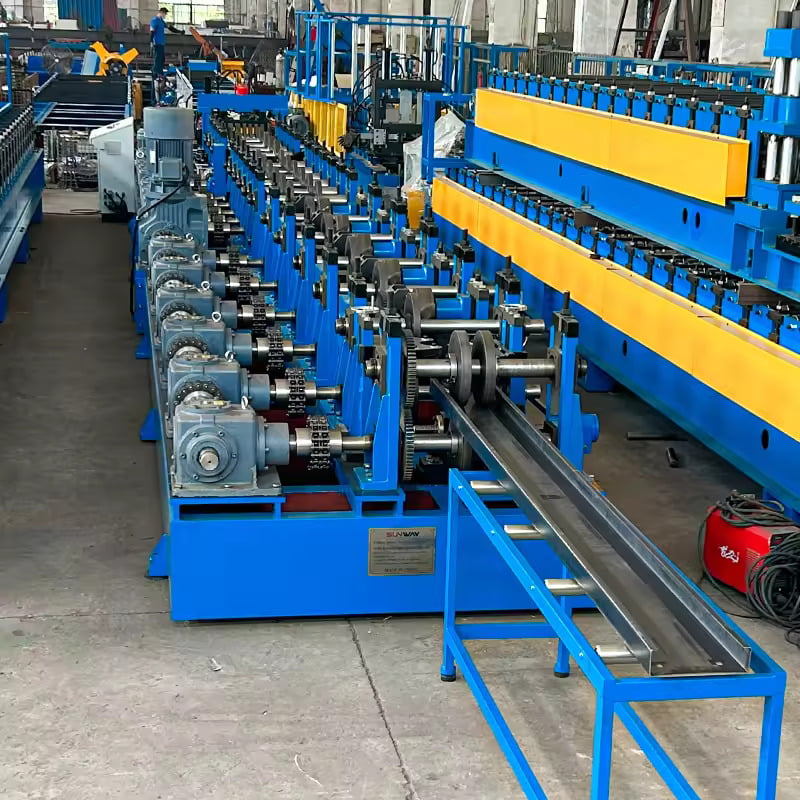
Types de profileuses : Adaptation aux différents besoins
Machines de profilage se présentent sous différentes formes et tailles, chacune étant adaptée à des applications spécifiques. Nous nous pencherons ici sur les spécificités de l'industrie de la pêche. types de machines de profilageIls sont classés selon les fonctions qu'ils remplissent.
| Type de machine | Description |
|---|---|
| Machine à une place | Un seul jeu de rouleaux utilisé, adapté aux formes simples et aux faibles volumes de production. |
| Machine multi-stand | Consiste en plusieurs stations de rouleaux pour des profils plus complexes et un rendement plus élevé. |
| Formage par rouleaux portatifs | Des machines plus petites et mobiles utilisées directement sur les chantiers de construction. |
| Profilage de précision | Machines de haute précision utilisées pour les pièces nécessitant des tolérances serrées. |
| Formage de rouleaux automatisé | Des machines entièrement automatisées avec une intervention humaine minimale, ce qui améliore la productivité. |
| Formage par roulage à grande vitesse | Conçus pour des débits élevés, ils conviennent aux environnements de production de masse. |
| Profilage hydraulique | Utilise la force hydraulique pour plier des matériaux plus lourds et plus épais. |
| Machine à servomoteur | Équipé de servomoteurs pour un contrôle plus précis du processus de formage. |
| Machine de profilage CNC | Contrôlé par ordinateur, il permet d'obtenir des formes et des profils hautement personnalisables. |
| Formage de rouleaux sur mesure | Construit spécifiquement pour répondre aux besoins des clients, adapté à des conceptions de produits uniques. |
Chaque type de machine présente ses propres avantages et inconvénients, en fonction des exigences de votre ligne de production. Comprendre quel modèle répond à vos besoins peut vous faire gagner du temps, de l'argent et des maux de tête.
Comment fonctionne une profileuse ? Le processus complet
Vous vous demandez peut-être : "Comment fonctionne exactement une profileuse ?". Il s'agit d'un processus fascinant, qui transforme le métal brut en profils précis par le biais d'un système continu et automatisé. Ci-dessous, nous décrivons l'ensemble du processus de fabrication d'une profileuse. processus de travail d'une machine de formage par rouleaux:
Processus de formage de rouleaux étape par étape
- Chargement des matériaux : Des bandes ou des bobines de métal brut sont introduites dans la machine. Les matériaux les plus couramment utilisés sont l'acier, l'aluminium ou le cuivre.
- Redressement initial : Le matériau passe par un dispositif de nivellement qui l'aplatit avant le début du formage.
- Stations de rouleaux : La bande passe par plusieurs stations de rouleaux, chaque station pliant le métal un peu plus jusqu'à l'obtention de la forme finale.
- Coupe à la longueur : Une fois le profil souhaité formé, le matériau est coupé à la longueur voulue à l'aide d'outils de coupe, qu'il s'agisse d'une fraise mécanique ou d'un laser.
- Collecte et empilage : Les produits finis sont collectés et empilés, prêts à être expédiés ou traités ultérieurement.
Cette opération transparente est très efficace et minimise les déchets, ce qui la rend idéale pour la production de masse.
Principaux composants d'une profileuse et leurs fonctions
Chaque pièce d'une profileuse joue un rôle crucial dans son bon fonctionnement et son efficacité. Jetons un coup d'œil sur les éléments clés et leurs fonctions.
| Composant | Fonction |
|---|---|
| Rouleaux | Il est chargé de façonner le métal selon le profil souhaité. |
| Alimentation en matériaux | Introduit le métal brut dans la machine à une vitesse constante. |
| Unité de redressement | Aplatit le matériau avant qu'il n'entre dans les stations de rouleaux. |
| Unité de coupure | Coupe le métal formé à la longueur requise après la mise en forme. |
| Moteur (électrique ou hydraulique) | Alimente les rouleaux et autres pièces mécaniques de la machine. |
| Contrôleur (CNC ou manuel) | Contrôle l'opération et ajuste les paramètres tels que la vitesse et la force. |
| Rouleaux de guidage | Maintenez la bande métallique alignée pendant qu'elle passe dans la machine. |
| Dérouleur | Maintient et libère la bobine de métal dans la machine. |
| Système de poinçonnage | Poinçonne des trous ou des fentes dans le matériau au cours du processus de formage. |
-
 Machine de formage de rouleaux de poteau de vignoble
Machine de formage de rouleaux de poteau de vignoble -
 Machine de formage de rouleaux de panne Sigma à taille variable automatique
Machine de formage de rouleaux de panne Sigma à taille variable automatique -
 Petit pain de cadre d'armoire électrique formant la machine
Petit pain de cadre d'armoire électrique formant la machine -
 Machine de formage de rouleaux de rail DIN
Machine de formage de rouleaux de rail DIN -
 Rouleau d'échelle de câble formant la machine
Rouleau d'échelle de câble formant la machine -
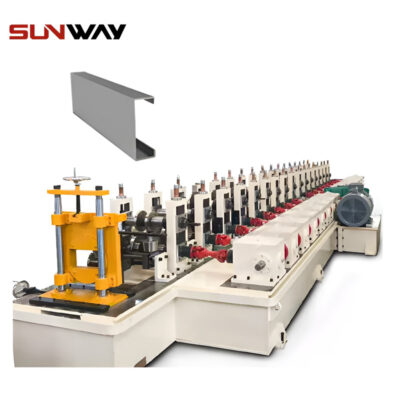 Support de montage PV Profilé en forme de C formant la machine
Support de montage PV Profilé en forme de C formant la machine -
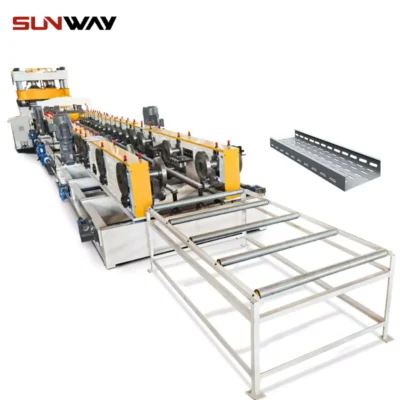 Rouleau de chemin de câbles formant la machine
Rouleau de chemin de câbles formant la machine -
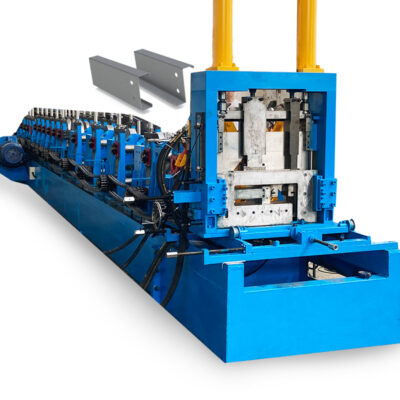 Laminage à froid de canal de panne de CZ formant le profil en acier galvanisé par pleine automatique de machine
Laminage à froid de canal de panne de CZ formant le profil en acier galvanisé par pleine automatique de machine -
 Machine de formage de rouleaux de support de montage PV (profil HAT / Omega)
Machine de formage de rouleaux de support de montage PV (profil HAT / Omega)
Vitesse et efficacité des machines : Ce que l'on peut attendre des profileuses
L'un des principaux facteurs à prendre en compte lors de l'achat d'un machine de formage de rouleaux est sa rapidité et son efficacité. Cet aspect est particulièrement important si vous travaillez dans un environnement de production à haut volume. Examinons les vitesses habituelles et leur incidence sur la productivité.
| Type de machine | Vitesse moyenne | Efficacité |
|---|---|---|
| Machine à une place | 5-10 mètres par minute | Efficacité moindre, adaptée aux petites séries. |
| Machine multi-stand | 20-30 mètres par minute | Efficacité élevée, idéale pour les tâches complexes et de grand volume |
| Formage par roulage à grande vitesse | 40-100 mètres par minute | Extrêmement efficace pour la production de masse. |
| Profilage de précision | 10-15 mètres par minute | Des vitesses plus lentes mais une très grande précision. |
| Profilage hydraulique | 5-15 mètres par minute | Plus lent mais idéal pour les matériaux lourds. |
Paramètres mécaniques personnalisés pour les profileuses
Chaque ligne de production est différente, c'est pourquoi la personnalisation est souvent nécessaire. Vous pouvez ajuster plusieurs paramètres mécaniques pour répondre à des besoins de fabrication spécifiques.
| Paramètres | Description |
|---|---|
| Epaisseur du matériau | La fourchette va de 0,3 mm à 5 mm, en fonction du type de métal. |
| Largeur du profil | Peut varier en fonction des exigences du client ; se situe généralement entre 100 mm et 800 mm. |
| Stations de formage | Le nombre de stations peut être personnalisé en fonction de la complexité du profil. |
| Longueur de coupe | Réglable pour produire des produits de différentes tailles, typiquement de 0,5 mètre à 12 mètres. |
| Capacités de poinçonnage | Modèles de poinçonnage personnalisables pour les trous, les fentes ou les encoches. |
| Puissance du moteur | Peut être ajusté en fonction du matériau et de la vitesse de production. |
| Type de contrôleur | Vous avez le choix entre des systèmes à commande numérique, manuels ou semi-automatiques. |
Applications des profileuses : Où sont-elles utilisées ?
Les profileuses sont polyvalentes et ont un large éventail d'applications. Voici une liste d'industries et de produits où ces machines sont couramment utilisées.
| Application | Description |
|---|---|
| Panneaux de toiture et de mur | Tôles ondulées utilisées dans la construction pour la couverture et le revêtement des murs. |
| Cadres de portes et de fenêtres | Produit des cadres pour les bâtiments résidentiels et industriels. |
| Industrie automobile | Créer des pièces métalliques pour les châssis et les éléments structurels des véhicules. |
| Conduits de chauffage, de ventilation et de climatisation | Utilisé dans la production de conduits pour le chauffage, la ventilation et la climatisation. |
| Meubles en acier | Façonne des profils métalliques utilisés dans le mobilier de bureau et industriel. |
| Armoires électriques | Produit des boîtiers pour les systèmes électriques et les armoires de commande. |
| Cadres pour panneaux solaires | Forme des profils métalliques pour le montage de panneaux solaires sur les toits. |
| Systèmes de stockage | Crée des étagères, des casiers et d'autres solutions de stockage. |
| Clôtures et garde-corps | Production de barrières de sécurité et de clôtures pour les autoroutes et les sites industriels. |
| Chemins de câbles | Façonne le métal pour en faire des plateaux qui supportent le câblage électrique. |
Installation, fonctionnement et entretien des profileuses
L'installation, le fonctionnement et l'entretien corrects d'une profileuse sont essentiels pour garantir une efficacité et des performances à long terme.
| Processus | Détails |
|---|---|
| Installation | L'alignement de la machine, les connexions électriques et les réglages hydrauliques doivent être corrects. |
| Fonctionnement | Il faut généralement des opérateurs formés qui comprennent les vitesses d'alimentation des matériaux et les commandes de la machine. |
| Maintenance | La lubrification régulière, le nettoyage et le remplacement des composants usés sont essentiels à la longévité. |
| Mesures de sécurité | Inclure des arrêts d'urgence, des protections de sécurité et des inspections régulières de la machine. |
| Dépannage | Les problèmes tels que le désalignement des matériaux ou l'usure des rouleaux peuvent être résolus par une intervention opportune. |
Choisir le bon fournisseur : Une décision clé
Lorsque vous investissez dans une profileuse, le choix du bon fournisseur peut faire toute la différence. Voici un aperçu des éléments à prendre en compte lors du choix d'un fournisseur.
| Facteur | Ce qu'il faut rechercher |
|---|---|
| Fourchette de prix | Comparez les prix de différents fournisseurs. Les machines peuvent aller de $50,000 à $200,000. |
| Réputation | Recherchez les avis des clients et la réputation du secteur. |
| Assistance et garantie | Recherchez des fournisseurs qui offrent des garanties étendues et un bon service après-vente. |
| Personnalisation | Assurez-vous que le fournisseur peut répondre à vos besoins spécifiques de personnalisation. |
| Localisation | Choisissez un fournisseur capable de fournir des services de livraison et d'assistance dans les délais impartis. |
Fournisseurs et fourchette de prix
| Fournisseur | Fourchette de prix (USD) | Localisation |
|---|---|---|
| Machines Samco | $60,000 – $150,000 | Canada |
| Jupiter Roll Forming | $50,000 – $180,000 | Inde |
| Yoder | $100,000 – $250,000 | ÉTATS-UNIS |
| Hangzhou Roll Forming | $45,000 – $120,000 | Chine |
| Groupe Formtek | $80,000 – $200,000 | ÉTATS-UNIS |
Avantages et inconvénients des profileuses : Avantages et limites
Comme tout équipement industriel, les profileuses ont leurs forces et leurs faiblesses. Jetons un coup d'œil sur une comparaison des avantages et des inconvénients.
Avantages
- Efficacité élevée de la production: Une fois réglée, la machine peut fonctionner en continu, produisant un grand volume de profilés métalliques avec un minimum de temps d'arrêt.
- Polyvalence: Peut être utilisé pour une grande variété de matériaux et de profils.
- Un minimum de déchets: Le processus de profilage en continu réduit les déchets de ferraille, ce qui le rend rentable et respectueux de l'environnement.
- Précision: Les machines sont très précises et produisent des pièces avec des tolérances serrées.
- Personnalisation: Facilement personnalisable pour produire des formes et des tailles différentes pour diverses industries.
Limites
- Investissement initial élevé: Le coût initial de l'achat et de l'installation d'une profileuse peut être considérable.
- Compétences spécialisées requises: Les opérateurs ont besoin d'une formation adéquate pour manipuler efficacement les machines.
- Limité à de longues séries de production: Le formage par laminage est mieux adapté aux longues séries de production, ce qui le rend moins efficace pour les petits lots.
Comment choisir un fournisseur de profileuses
Le choix du bon fournisseur est crucial lorsque l'on investit dans une profileuse. Voici les principaux éléments à prendre en compte :
Facteurs à prendre en compte lors du choix d'un fournisseur
- Réputation: Il faut toujours s'adresser à des fournisseurs qui ont fait leurs preuves en matière de livraison de machines de haute qualité.
- Personnalisation: Assurez-vous que le fournisseur peut répondre à vos exigences exactes en termes de conception et de rendement de la machine.
- Services d'appui: L'assistance après-vente, y compris l'installation, la maintenance et les réparations, est essentielle.
- Prix: Si le prix est important, il ne doit pas être le seul facteur décisif. Concentrez-vous sur la valeur offerte par le fournisseur.
- Garanties: Un fournisseur qui offre une bonne garantie indique qu'il a confiance en son produit.
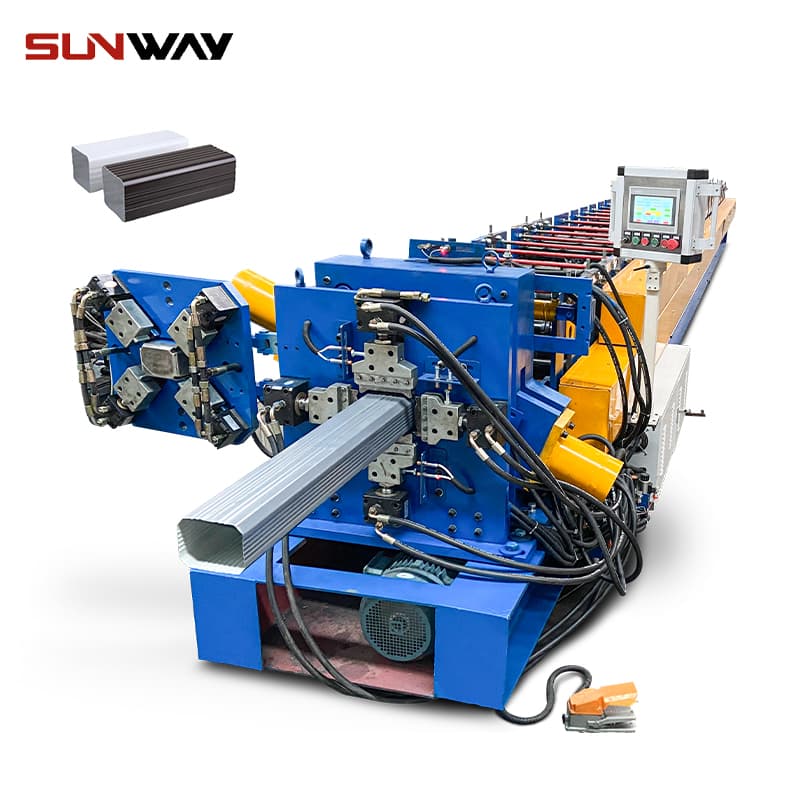
FAQ
| Question | Réponse |
|---|---|
| À quoi sert une profileuse ? | Une profileuse est utilisée pour façonner des bandes de métal plat dans les profils souhaités pour la construction et l'industrie. |
| Le profilage peut-il être personnalisé ? | Oui, les profileuses peuvent être personnalisées pour produire une large gamme de formes, de tailles et de conceptions. |
| Quels matériaux peuvent être utilisés dans le formage par roulage ? | Les métaux tels que l'acier, l'aluminium, le cuivre et le zinc sont couramment utilisés dans les profileuses. |
| Quelle est la vitesse des machines de profilage ? | Les vitesses peuvent varier de 5 à 100 mètres par minute, en fonction du type de machine et du matériau. |
| Combien coûtent les profileuses ? | Les prix varient considérablement, de $50 000 à plus de $200 000, en fonction des capacités de la machine. |
Conclusion
Vous devriez maintenant avoir une bonne compréhension de ce qu'est un machine de formage de rouleaux Comment fonctionne-t-il et s'adapte-t-il à vos besoins de production ? Que vous recherchiez une production en grande quantité ou des profils personnalisés complexes, il existe une machine pour vous. L'essentiel est de comprendre vos besoins spécifiques et de les associer à la bonne machine et au bon fournisseur.
En suivant ce guide, vous serez en mesure de prendre une décision éclairée qui profitera à votre entreprise pour les années à venir.
en savoir plus Formage de rouleaux
Foire aux questions (FAQ)
1) Quelles sont les tolérances qu'une profileuse moderne peut atteindre ?
- Avec des supports de précision, un outillage de qualité et des avances servo, il faut s'attendre à ±0,3-0,5 mm sur les dimensions critiques et ±0,5-1,0 mm sur la longueur de coupe à des vitesses typiques. Les lignes d'ultra-précision avec jauge en ligne peuvent atteindre ±0,2 mm sur la hauteur du profil.
2) Comment choisir entre les coupures hydrauliques, mécaniques et servo-motorisées ?
- Hydraulique : robuste pour les jauges épaisses et les forces de cisaillement élevées. Mécanique (came/volant) : économique pour les jauges fines à moyennes. Tronçonnage à la volée par servomoteur : idéal pour les vitesses élevées et les tolérances de longueur serrées avec un minimum de bavures.
3) Une ligne de profilage peut-elle produire plusieurs profils ?
- Oui. Les options comprennent l'outillage à cassettes, les bases rafistolées et les ensembles de fleurs à changement rapide. Les changements peuvent passer de 3 à 6 heures à 30 à 60 minutes grâce aux cassettes pré-alignées et aux recettes numériques.
4) Quels sont les problèmes de qualité des bobines qui affectent le plus les rebuts ?
- Ondulation de la couronne/du bord de la bobine, variation de l'épaisseur, contraintes résiduelles et mauvaise lubrification de la surface. Atténuer ces problèmes grâce à des spécifications de planéité à l'arrivée (I-unit/STM), à la cartographie de la bobine et à l'optimisation de l'entraînement/du redresseur.
5) Quelles sont les normes ou certifications importantes pour l'exportation ?
- ISO 9001 (gestion de la qualité), CE/UKCA (sécurité des machines), IEC/UL/CSA (électricité) et spécifications spécifiques aux produits comme EN 1090 pour les composants structurels ou AAMA/ASTM pour les profilés de construction. Pour l'automobile, les normes PPAP et IATF 16949 peuvent être exigées.
2025 Tendances de l'industrie
- L'optimisation des réglages pilotée par l'IA permet de réduire de 20 à 35% les rebuts au départ grâce à l'utilisation de jumeaux numériques des rouleaux de fleurs.
- L'adoption des aciers revêtus de Zn-Al-Mg (ZM120-ZM275) s'accélère pour les profils de construction en raison d'une durée de vie contre la corrosion de 2 à 4 fois supérieure à celle du G90.
- Les IHM à faible codage et les changements guidés réduisent le temps de formation de ~30% et le temps de changement de 40-60%.
- Les entraînements intelligents sur le plan énergétique et les systèmes hydrauliques régénératifs réduisent de 10-18% le nombre de kWh/tonne.
- La métrologie par vision en ligne se généralise pour les contrôles dimensionnels de 100%, ce qui permet un SPC en temps réel et des ajustements automatiques des stands.
- Résilience de la chaîne d'approvisionnement : de plus en plus d'acheteurs demandent un double approvisionnement pour l'outillage et l'électronique critiques, et spécifient des accords de niveau de service locaux.
Aperçu du marché et de la technologie (2013-2025 est.)
| Métrique | 2023 | 2024 | 2025 (estimation) | Notes/Sources |
|---|---|---|---|---|
| Marché mondial des produits formés par laminage (milliards d'USD) | 63.5 | 66.9 | 71.2 | Synthèse des rapports de l'industrie : MarketsandMarkets, Grand View Research |
| Vitesse moyenne de la ligne pour les profils de construction (m/min) | 35 | 37 | 40 | Catalogues des fournisseurs, informations sur les foires commerciales |
| Usines utilisant la maintenance prédictive (%) | 28% | 35% | 45% | Deloitte 2024-2025 Perspectives de l'industrie manufacturière |
| Part de Zn-Al-Mg dans les bobines de construction (%) | 20% | 26% | 33% | Fiches techniques ArcelorMittal Magnelis, Nippon Steel ZAM |
| Intensité énergétique typique (kWh/tonne formée) | 110 | 104 | 96 | Études de cas d'équipementiers ; critères de référence internes |
| Part des lignes avec vision en ligne/SPC (%) | 18% | 25% | 38% | Données sur les exposants de l'EMO/EuroBLECH |
Références clés :
- EN 10169, EN 10346 pour les aciers revêtus ; AISI/COS pour les directives relatives au profilage.
- Deloitte Global Manufacturing Outlook 2025 (en anglais)
- Données techniques ArcelorMittal Magnelis, Nippon Steel ZAM
- ISO 14644 (propreté pour l'assemblage électronique automobile) ; normes IEC/UL pour les panneaux de contrôle
Derniers cas de recherche
Étude de cas 1 : L'installation assistée par un jumelage numérique permet de réduire les déchets (2024)
- Contexte : Un fabricant européen de produits de construction utilisait des bobines prépeintes de 0,5 à 0,8 mm sur une machine de formage à rouleaux à plusieurs postes, avec des changements fréquents de largeur/profil, ce qui entraînait des déchets de démarrage moyens de 4,2%.
- Solution : Mise en œuvre d'un jumeau numérique de la fleur de cylindre basé sur la physique (modèle de retour élastique basé sur les éléments finis) lié aux recettes de l'automate programmable ; ajout d'un positionnement servo du support et d'un contrôle par caméra en ligne pour les ajustements en boucle fermée.
- Résultats : Réduction des déchets de première monte à 2,3% (-45%), réduction du temps moyen de changement de série de 52 minutes, OEE +7,8 points. Sources : Altair Inspire/Form case literature ; OEM white papers on closed-loop forming.
Étude de cas n° 2 : Conversion Zn-Al-Mg pour les toitures côtières (2025)
- Contexte : Un fabricant de l'APAC avait besoin d'une durée de vie plus longue contre la corrosion sans augmenter l'épaisseur ou le coût au mètre pour des projets côtiers.
- Solution : Passage du G90 au ZM250 ; amélioration de la surface de l'outil (TiN) et du lubrifiant afin de réduire le ramassage ; recalibrage des supports pour le contrôle de la fissuration des bords ; ajout d'un protocole d'assurance qualité par pulvérisation de sel.
- Résultats : Durée de vie prévue +2,7× ; incidents liés à l'enrobage -80% ; réduction des réclamations au titre de la garantie de 60% par rapport à l'année précédente ; coût net par mètre installé -5,5%. Sources : ArcelorMittal Fiches techniques Magnelis d'ArcelorMittal ; rapports d'assurance qualité du projet.
Avis d'experts
- Hannah Vogt, responsable de l'ingénierie des procédés, Formtek Group
- Point de vue : "Le différentiateur de 2025 est le contrôle en boucle fermée. Les lignes qui associent la vision en ligne au positionnement servo des supports maintiennent un Cp/Cpk >1,33 sur les dimensions critiques, même en cas de changement de lot de bobines."
- Jorge Almeida, directeur des opérations, Samco Machinery
- Point de vue : "Les cassettes à changement rapide et les radeaux standardisés transforment la demande multi-profils d'un goulot d'étranglement en un centre de profit. Visez des temps de changement inférieurs à 60 minutes pour protéger l'OEE."
- Wei-Lun Chen, Sciences des matériaux, Université nationale de Taïwan (conseiller industriel)
- Point de vue : "Les revêtements Zn-Al-Mg et les stratégies améliorées d'intégrité des arêtes permettent aux fabricants de réduire l'épaisseur de manière responsable. Toutefois, la finition de l'outillage et le choix de la lubrification ne sont pas négociables."
Outils/ressources pratiques
- Simulation de laminage : https://altair.com/inspire-form et https://www.qform3d.com
- Normes et spécifications : EN 10346/EN 10169 (CEN) : https://standards.cen.euGuides de conception de l'AISI : https://www.seaisiorg.org
- Plateformes de maintenance prédictive : Siemens MindSphere https://siemens.com/mindspherePTC ThingWorx https://www.ptc.com/thingworx
- Métrologie en ligne/SPC : systèmes de vision Keyence https://www.keyence.comMinitab SPC https://www.minitab.com
- Données techniques de l'acier revêtu : ArcelorMittal Magnelis https://construction.arcelormittal.com/magnelisNippon Steel ZAM https://www.nipponsteel.com
- Sécurité et conformité des machines : Aperçu du règlement de l'UE sur les machines (2023/1230) à l'adresse suivante https://ec.europa.eu
Conseils d'optimisation pour les acheteurs de profileuses :
- Préciser la précision de l'avance servo ±0,1 mm et la coupure volante avec synchronisation par encodeur.
- Demande d'outils à cassette avec des cales préréglées et des identifiants de recettes numériques pour réduire les changements.
- Ajouter une jauge de vision en ligne pour les contrôles 100% de la hauteur/largeur du profil ; enregistrer dans le SPC.
- Exiger la mesure de l'énergie par poste (kWh/tonne) et des capteurs de maintenance prédictive sur les postes critiques.
- Valider à l'aide d'un support numérique : plan de la bobine, rapport de la première pièce et documentation de type PPAP.
Note sur l'approvisionnement : vérifiez les références des fournisseurs dans les secteurs de la construction, de l'automobile et de l'énergie ; insistez sur les accords de service locaux et le stockage des pièces de rechange pour les entraînements, les automates programmables et les systèmes hydrauliques.
Dernière mise à jour : 2025-10-28
Changelog : Ajout de 5 FAQ ; insertion du tableau des tendances 2025 et des données du marché ; inclusion de deux études de cas 2024/2025 ; compilation des points de vue d'experts ; liste d'outils/ressources pratiques ; ajout de conseils d'optimisation pour les acheteurs.
Prochaine date de révision et déclencheurs : 2026-04-30 ou plus tôt si des mises à jour du règlement de l'UE sur les machines, des changements majeurs dans les directives sur le Zn-Al-Mg, ou des progrès significatifs dans la métrologie en ligne/l'optimisation de la configuration de l'IA ont lieu.
